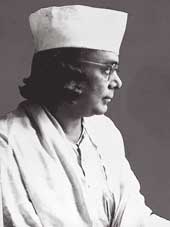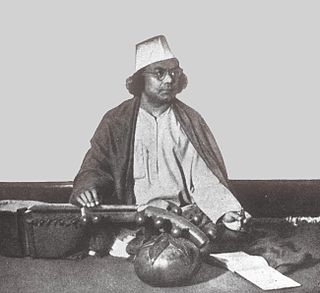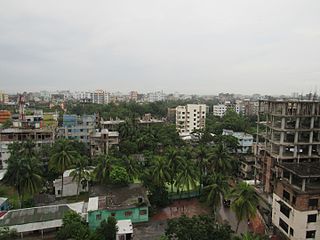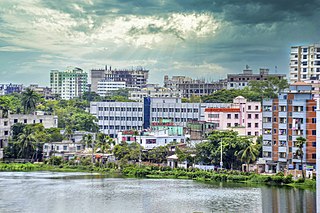
Bengali poetry is a rich tradition of poetry in the Bengali language and has many different forms. Originating in the Bengal region of South Asia, the history of Bengali poetry underwent three successive stages of development: poetry of the early age, the Medieval period and the age of modern poetry. All ages have seen different forms of poetry and poetical tradition. It reached the pinnacle during the Bengali Renaissance period although it has a rich tradition and has grown independent of the movement. Major Bengali Poets throughout the ages are Chandidas, Alaol, Ramprasad Sen, Michael Madhusudan Dutt, Nabinchandra Sen, Rabindranath Tagore, Dwijendralal Ray, Satyendranath Dutta, Kazi Nazrul Islam, Jibanananda Das, Jasimuddin, Sukanta Battacharya, Al Mahmud.

Kazi Nazrul Islam was a Bengali poet, writer, musician, and is the national poet of Bangladesh. Nazrul is regarded as one of the greatest poets in Bengali literature. Popularly known as Nazrul, he produced a large body of poetry, music, messages, novels, stories, etc. with themes that included equality, justice, anti-imperialism, humanity, rebellion against oppression and religious devotion. Nazrul's activism for political and social justice as well as writing a poem titled as "Bidrohī", meaning "the rebel" in Bengali, earned him the title of "Bidrohī Kôbi". His compositions form the avant-garde music genre of Nazrul Gīti.

Comilla District, officially known as Cumilla District, is a district of Bangladesh located about 100 kilometres south east of Dhaka. Comilla is bordered by Brahmanbaria and Narayanganj districts to the north, Noakhali and Feni districts to the south, Tripura of India to the east and Munshiganj and Chandpur districts to the west. Comilla district is located in the southeastern part of Bangladesh.

Ahsan Manzil is a palace located in the Kumartoli area of Dhaka, Bangladesh. It was formerly the residence and seat of the Nawab of Dhaka and has been designated an Old Dhaka Heritage Site. It now serves as a museum.

The Bangla Academy is an autonomous institution funded by the Bangladesh government that fosters the Bengali language, literature and culture, works to develop and implement national language policy and to do original research in the Bengali language. Established in 1955, it is located in Burdwan House in Ramna, Dhaka, within the grounds of the University of Dhaka and Suhrawardy Udyan. The Bangla Academy hosts the annual Ekushey Book Fair.

Hinduism is the second largest religious affiliation in People's Republic of Bangladesh, as according to the Official 2022 Census of Bangladesh, approximately 13.1 million people responded that they were Hindus, constituting 7.95% out of the total population of 165.15 million people. In terms of population, Bangladesh is the third-largest Hindu populated country of the world, just after India and Nepal. Hinduism is the second-largest religion in 61 out of 64 districts of Bangladesh, but there is no Hindu majority district in Bangladesh.

Brahmanbaria is a district in eastern Bangladesh located in the Chittagong Division. Geographically, it is mostly farmland and is topographically part of the Gangetic Plain. It is bounded by the districts of Kishoreganj and Habiganj to the north, Narsingdi District and Narayanganj to the west, Comilla to the south, and the Indian state of Tripura to its east. It was a part of Comilla District until 15 February 1984.

Bengali novels occupy a major part of Bengali literature. Though the first Bengali novel was Karuna O Phulmonir Bibaran (1852), the Bengali novel actually started its journey with Durgeshnandini written by Bankim Chandra Chattopadhyay in 1865. According to Ananda Sanker and Lila Ray, 'when the novel was introduced in Bengali in the middle of the 19th century, the form itself was new, the prose in which it was written was new, the secular tone was new in a country hitherto wholly dominated by religion, and the society in which and for which it was written was new' (p. 168). But some great novelists like Bankim Chandra Chatterjee, Rabindranath Tagore, Manik Bandopadhyay, Tarashankar Bandopadhyay, and Sarat Chandra Chattopadhyay developed the newly introduced genre in such a way that 'new' changed into 'matured' through their works. Almost all these literary activities went on in full swing in Kolkata. Dhaka, on the other hand, could not participate in the early stage, but literature created by and of the people of Bangladesh area later on flourished with notable success.

Shahbag or Shahbagh is a major neighbourhood and a police precinct or thana in Dhaka, the capital and largest city of Bangladesh. It is also a major public transport hub. It is a junction between two contrasting sections of the city—Old Dhaka and New Dhaka—which lie, respectively, to its south and north. Developed in the 17th century during Mughal rule in Bengal, when Old Dhaka was the provincial capital and a centre of the flourishing muslin industry, it came to neglect and decay in early 19th century. In the mid-19th century, the Shahbag area was developed as New Dhaka became a provincial centre of the British Raj, ending a century of decline brought on by the passing of Mughal rule.
Madhabpur is an upazila (sub-district) of Habiganj District, located in Bangladesh's Sylhet Division.

The culture of Bengal defines the cultural heritage of the Bengali people native to eastern regions of the Indian subcontinent, mainly what is today Bangladesh and the Indian states of West Bengal and Tripura, where the Bengali language is the official and primary language. Bengal has a recorded history of 3,100 years. The Bengali people are its dominant ethnolinguistic group. The region has been a historical melting point, blending indigenous traditions with cosmopolitan influences from pan-Indian subcontinental empires. Bengal was considered to be the richest part of Islamic medieval India and during the era of the Bengal Sultanate it was described to be a major trading nation in the world, while during Mughal times, having triggered the proto-industrialization, its economy was worth 12% of global GDP. Dhaka became the capital of Mughal Bengal and the commercial (financial) capital (1610-1757) of Mughal India. Dhaka became one of the richest and greatest cities in the world and the prosperity of Dhaka reached its peak during this time. The current (2022) estimated GDP (Nominal) of Dhaka is $200 Billion. As a part of the Bengal Presidency, Bengal also hosted the region's most advanced political and cultural centers during British rule. Kolkata became the capital (1758-1911) and the financial capital (1758-1947) of the British India. Kolkata grew rapidly in the 19th century to become one of the richest and greatest cities in the world and the second most important city of the British Empire after London. The current (2022) estimated GDP (Nominal) of Kolkata is $100 Billion. Historically Feudalism has been widespread in the entire eastern Indian region. The feudal system flourished to a large extent under the British administration, which served as a means to exploit the Indian peasants by the British colonizers. This created a class of rich landlords in Bengal and a large population of poor peasants. It is noteworthy that a major portion of the Bengali intellectual community during the British era emerged from this wealthy class of landlords, as primarily they belonged to well educated families and got the economic opportunities to receive English education, often from abroad. The lower social classes remained in abject poverty and illiteracy. Thus, although the contribution of the Bengali intellectual community has been immense towards literature, science, politics and the Indian freedom movement, but still as it flourished under an exploitative imperial government, it mostly constituted of individuals belonging to the wealthy landlord families.

Comilla, officially spelled Cumilla, is a metropolis on the banks of the Gomti River in the southeastern tip of Bangladesh. Comilla was one of the cities of ancient Bengal. Also the city of Comilla was once the capital of Epura kingdom. Comilla Airport is located in the Dulipara area of Comilla city. Along with the Comilla Economic Zone EPZ, various industrial factories have come up at the airport, making the airport area a business and commercial city. Comilla City is a division centered city district with surrounding districts coming to Comilla in more diverse areas of work. Besides, Bibi Bazar land port has come up 5 km away from Comilla city. The area of Comilla City Corporation is 53.04 square kilometers, so the surrounding areas of the main city fall under the jurisdiction of the City Corporation. The urban areas falling outside the city corporation are considered as suburbs with a population of 6 lakhs.

Old Dhaka is a term used to refer to the historic old city of Dhaka, the capital of Bangladesh. It was founded in 1608 as Jahangirabad or Jahangirnagar, the capital of Mughal Province of Bengal and named after the Mughal emperor Jahangir. It is located on the banks of the Buriganga River. It was one of the largest and most prosperous cities of South Asia and the center of the worldwide muslin trade. The then Nawab of Bengal Murshid Quli Khan shifted the capital from Dhaka to Murshidabad in the early-18th century. With the rise of Calcutta during the British rule, Dhaka began to decline and came to be known as the "City of Magnificent Ruins". The British however began to develop the modern city from the mid-19th century.

Northbrook Hall was originally built as a town hall during the British period. It is situated at Farashgonj road in Old Dhaka, Bangladesh, on the north bank of the Buriganga River.

Bashirul Haq was a Bangladeshi architect, town planner and educator. He is regarded as one of the most influential architects in South Asia.

The architecture of Dhaka is a confluence of many architectural styles. From the Sena temples built by Ballal Sen, to the Mughal architecture of the Mughals, to the Indo-Saracenic style of the colonial era, to 20th century steel and chrome of skyscrapers. Dhaka has a colonial core in the river port area, surrounded by progressively newer areas as one travels away from the Buriganga, punctuated with old temples, churches and mosques.
M Harunur Rashid is a distinguished teacher of English literature and language, a notable educational administrator, editor and translator of modern poetry and prose, in Bangladesh, a noted writer of Sufism and Sufi literature and a commentator of social, political, cultural scene and literary texts.
Tikatuli is a residential/commercial neighborhood of Dhaka, the capital of Bangladesh.
A series of rallies, demonstrations, and blockades opposing the visit of the Indian Prime Minister Narendra Modi were held in Bangladesh from 19 to 29 March, on the celebration of the birth centenary of Bangabandhu Sheikh Mujibur Rahman and the 50th anniversary of Bangladesh's independence from Pakistan. Accusing Narendra Modi of committing crimes against humanity during the 2002 Gujarat riots, the protesters agitated against what they alleged were India's anti-Muslim policies and India's interference in Bangladeshi politics. Protesters demanded the cancellation of the Bangladesh government's invitation to the Indian Prime Minister. The otherwise peaceful protests turned violent when the protesters were attacked by the supporters of the ruling Awami League party along with a crackdown by the law-enforcement agencies, causing the deaths of several protesters throughout the last week of March 2021 in Bangladesh. Initially launched by progressive student organizations including the Bangladesh Students Union, Bangladesh Sadharon Chhatra Odhikar Songrokkhon Parishad, and the Socialist Students' Front, the demonstrations were later joined by the Islamic group Hefazat-e-Islam Bangladesh.




















